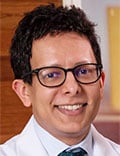LONG BEACH, California ― Supervised exercise has enormous potential to improve the outcomes for people with heart failure with preserved ejection fraction (HFpEF). That was one message at a session on heart failure in older patients at the American Geriatrics Society (AGS) 2023 Annual Scientific Meeting.
HFpEF accounts for about half of all cases of heart failure and affects an estimated 10% of Americans older than 75 years. In a scientific statement issued in March 2023 by the American Heart Association and the American College of Cardiology, experts said supervised exercise training, unlike most drugs, has produced consistent improvement in exercise capacity for those with HFpEF.
Speakers also discussed the latest information on risks, diagnosis, pharmacologic management, and inequities in access to care.
Supervised Exercise
The case for physical rehabilitation, or supervised exercise training, to help patients with HFpEF is strong, said Amy M. Pastva, PT, MA, PhD, professor of orthopedics, medicine, population health, and cell biology at Duke University School of Medicine, in Durham, North Carolina. Pastva cited the scientific statement, published studies, and an ongoing multicenter study funded by the National Institute on Aging.

Dr Amy Pastva
"When we look at trials of exercise-based interventions in chronic HFpEF, we have consistently demonstrated these large, significant, clinically meaningful improvements in symptoms, exercise capacity, and, usually, quality of life," she said.
These may be attributed to the pleiotropic effects of such training, she said, and may affect the full range of abnormalities that contribute to exercise intolerance. These peripheral effects can drive changes in exercise capacity. "What we don't know yet in these trials is whether it affects clinical events," she said. "But exercise capacity or cardiorespiratory fitness is an independent, clinically meaningful patient outcome."
Pastva highlighted some of the trials cited in the scientific statement that show positive results. However, she said, gaps remain, and information about how much exercise is ideal, among other questions, is needed. "We know about the short term, but not as much about the long term," she said.
Another interesting area of research, Pastva said, is the effect of combining interventions, such as weight loss, with supervised exercise. She cited a recently published study that focused on the effect of adding resistance training to caloric restriction and exercise training for HFpEF patients with obesity. The researchers found large improvement in VO2peak and quality of life with restriction and training; adding resistance training increased leg strength and muscle quality without additional effects on either measure.
"The addition of resistance training to the caloric restriction was well tolerated," she said. Physical rehabilitation that begins during the hospital stay and continues for 3 months after also could help frail, older patients who are hospitalized for acute decompensated heart failure with HFpEF, Pastva said, citing her research and that of other groups.
These ideas led to the REHAB-HFpEF trial, which began earlier this year. The trial is expected to be completed by 2025. The study aims to follow up to 880 older men and women with HFpEF who have been hospitalized for heart failure. The participants will be randomly assigned before discharge either to undergo physical rehabilitation three times per week for 12 weeks or to receive conventional care. The primary outcome is hospitalization and death at 6 months.
Other speakers updated epidemiology, diagnosis, pharmacology, and inequities.
Epidemiology and Diagnosis of HFpEF
HFpEF was initially believed to be a milder form of heart failure, but that is no longer thought to be the case, according to Michael W. Rich, MD, a professor of medicine at Washington University School of Medicine in St. Louis.
HFpEF is defined as heart failure with an ejection fraction of 50% or more. Women are twice as likely as men to have the condition; the incidence in Blacks is higher than in Whites, as is the rate of increase. From 2008–2018, the increase in hospitalizations rose 2.6-fold.
Signs and symptoms of this form of heart failure include dyspnea on exertion, exercise intolerance, rales, and elevated jugular venous pressure, he said.
"Diagnosis of HFpEF can also be done using the so-called H2F-PEF Score, which includes weight, high blood pressure, atrial fibrillation, pulmonary hypertension, older age, and elevated filling pressure," Rich said. "It's been shown in those with unexplained dyspnea, an H2F-PEF score of 6 points or higher is highly diagnostic of HFpEF."
Regarding the biomarker B-type natriuretic peptide, Rich said the diagnostic threshold for NT-pro-BNP is ≥450 pg/mL for those yougner than 50 years, ≥900 pg/mL for those aged 50–75 years, and 1800 ≥450 pg/mL for those aged 75 years and older. If the result is <300 pg/mL, acute heart failure is unlikely at any age, he said.
Evaluation should include a history and physical, labs (CBC, CMP, TFTs, UA, possibly lipids), a 12-lead ECG, and transthoracic echo with Doppler. Additional testing, decided on an individualized basis, may be needed. The differential diagnosis includes cardiac amyloid, hypertrophic cardiomyopathy, cardiac sarcoid, iron overload, tumors, esophageal enlargement, and other problems.
Rich advises physicians to refer for cardiac consultation when a patient is hospitalized more than twice in a year, when the patient's blood pressure is low (<90–100 mm Hg) or if the patient has diuretic resistance or cardiorenal syndrome.
Pharmacologic Management
Managing pharmacotherapy for HFpEF involves inherent tension between therapy benefits and the risks of polypharmacy, said Parag Goyal, MD, director of the HFpEF and Cardiac Amyloidosis Program and associate professor of medicine at Weill Cornell Medicine, in New York City.
Goyal provided several recommendations to balance that tension.
Decongestion should be effected with loop diuretics. Which is the best? Goyal cited a 2023 study that compared torsemide and furosemide. There was no difference in mortality at the 12-month follow-up, he said. "It probably doesn't make any difference which diuretic you use," but the medications help patients feel better and stay out of the hospital.
SGLT-2 inhibitors should be prescribed. "Multiple organs are involved in HFpEF, and that includes the heart, vasculature, and kidneys, and SGLT-2 inhibitors actually target each of these," he said.
Mineralocorticoid receptor agonists should be prescirbed. A post hoc analysis of the TOPCAT (Treatment of Preserved Cardiac Function Heart Failure With an Aldosterone Antagonist) trial found that in the Americas, but not in Russia, spironolactone reduced cardiovascular deaths and hospitalizations from heart failure.
Other medications to consider include angiotensin receptor/neprilysin inhibitors, angiotensin receptor blockers, and angiotensin-converting enzyme inhibitors. But caution should be exercised if the patient has low blood pressure, he said.
Consideration should be given to deprescribing beta blockers, which may not be helpful, Goyal said, citing recent research.
Use of statins should be considered. "The jury is still out," he said, but he also cited preliminary research from his group and others that found benefit.

Dr Parag Goyal
"The field is moving toward phenotype-based therapy," he said, which makes more individualized treatments possible.
Inequities
Heart failure affects everyone, said Khadijah Breathett, MD, an advanced heart failure and transplant cardiologist and associate professor of medicine at Indiana University, in Indianapolis. Ethnic and racial differences exist, she said.

Dr Khadijah Breathett
Datasets differ, and the changing definitions make assessing differences more complicated. Overall, she said, the highest prevalence of heart failure is among Black patients; the condition affects 3.6% of Black men and 3.3% of Black women, compared to 2.4% of White men and 1.4% of White women. Inequities are worsening.
Rates of hospitalizations for HFpEF are higher among Black patients, but mortality is higher among Whites, and men fare worse than women.
Breathett's research and that of others has found in a multiracial cohort that obesity and hypertension were strong risk factors for HFpEF, with obesity strongest for Black women.
Advice for clinicians? Pay heed to the 2022 ACC/AHA heart failure guidelines, she advised, which recommend addressing risk factors often found in the disparities.
"Support clinical trials so we can get better data," she added.
Rich and Pastva have disclosed no relevant financial relationships. Goyal has received research support from the National Institute on Aging and the American Heart Association. Breathett has received funding from the National Heart, Lung, and Blood Institute and HRSA Prime.
American Geriatrics Society (AGS) 2023 Annual Scientific Meeting: Presented May 5, 2023.
For more news, follow Medscape on Facebook, Twitter, Instagram, and YouTube.
Credits:
Lead image: Rodo/Dreamstime
Image 1: Dr Amy Pastva
Image 2: Duke University School of Medicine
Image 3: Brandon Wright
Medscape Medical News © 2023
Cite this: Heart Failure With Preserved EF: New Insights, Respect for Exercise? - Medscape - May 16, 2023.











Comments